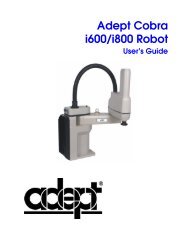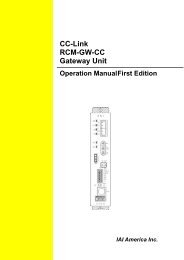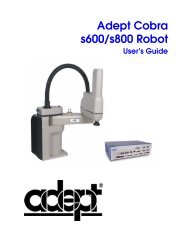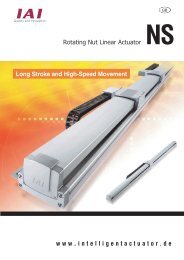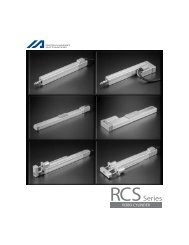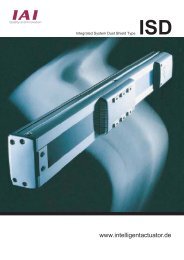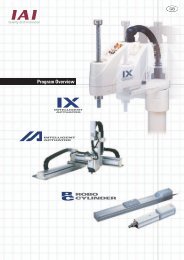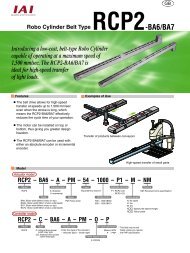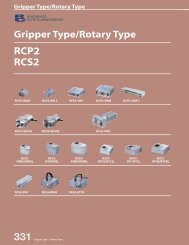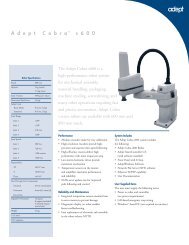Download Adept Cobra PLC600 User's Guide - pulsar.com.tr
Download Adept Cobra PLC600 User's Guide - pulsar.com.tr
Download Adept Cobra PLC600 User's Guide - pulsar.com.tr
You also want an ePaper? Increase the reach of your titles
YUMPU automatically turns print PDFs into web optimized ePapers that Google loves.
Programming the Robot<br />
When defining a pallet, please note the following:<br />
• The first position in the pallet is position 1 (not zero).<br />
• The even-numbered rows, if offset, are always offset by half the distance between<br />
positions in a row (F243:4 or <s<strong>tr</strong>ong>Adept</s<strong>tr</strong>ong>_Pallet.4).<br />
• The <strong>tr</strong>aversal value (F243:68 or <s<strong>tr</strong>ong>Adept</s<strong>tr</strong>ong>_Pallet.68) can be either 0 or 1. If the value is<br />
0, the rows are all <strong>tr</strong>aversed in the same direction. If the value is 1, he<br />
even-numbered rows are <strong>tr</strong>aversed in the direction opposite that of the<br />
odd-numbered rows.<br />
• The spacing between rows is constant for all rows (odd-numbered and<br />
even-numbered).<br />
To define a pallet in the PLC Server:<br />
1. Enter the pallet location parameters and pallet spacing parameters into the<br />
registers listed in Table 6-13. See “Defining a Pallet Layout” on page 145 for<br />
details on defining a pallet.<br />
2. Enter the number of the pallet to be defined into N240:8 or <s<strong>tr</strong>ong>Adept</s<strong>tr</strong>ong>_Pallet_Number.<br />
3. Turn on the “define pallet” <s<strong>tr</strong>ong>com</s<strong>tr</strong>ong>mand bit (N240:0/10 or<br />
<s<strong>tr</strong>ong>Adept</s<strong>tr</strong>ong>_Command_Bits.10)<br />
4. Wait for the “<s<strong>tr</strong>ong>com</s<strong>tr</strong>ong>mand executing” bit to be set (N241:0/5 or<br />
<s<strong>tr</strong>ong>Adept</s<strong>tr</strong>ong>_Status_Bits.5).<br />
5. Turn off the “define pallet” <s<strong>tr</strong>ong>com</s<strong>tr</strong>ong>mand bit.<br />
21 22 23 24 25<br />
C<br />
21 22 23 24 25<br />
C<br />
16 17 18 19 20<br />
20<br />
19<br />
18<br />
17<br />
16<br />
11 12 13 14 15<br />
11 12 13 14 15<br />
6 7 8 9 10<br />
10<br />
9<br />
8<br />
7<br />
6<br />
Start 1 2 3 4 5<br />
A<br />
B<br />
Traverse Dir. = 0<br />
Start 1 2 3 4 5<br />
A<br />
B<br />
Traverse Dir. = 1<br />
A Origin<br />
B Last location in<br />
origin row<br />
Figure 6-6. Traverse Direction<br />
C Location on pallet<br />
(not in origin row)<br />
NOTE:<br />
1. The initial <strong>tr</strong>averse direction is always from A to B.<br />
2. When defining the pallet, if location C is taught on the same line (row)<br />
as A and B, an error will be reported.<br />
98 <s<strong>tr</strong>ong>Adept</s<strong>tr</strong>ong> <s<strong>tr</strong>ong>Cobra</s<strong>tr</strong>ong> <s<strong>tr</strong>ong>PLC600</s<strong>tr</strong>ong>/PLC800 Robot User’s <s<strong>tr</strong>ong>Guide</s<strong>tr</strong>ong>, Rev B



